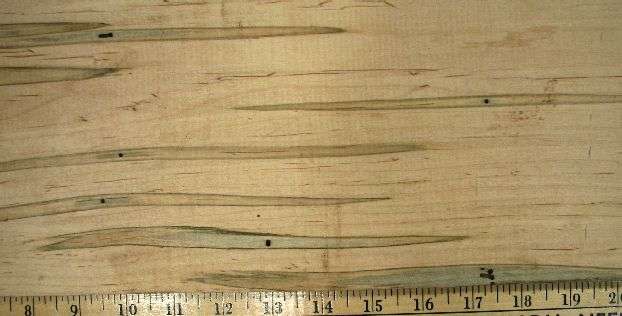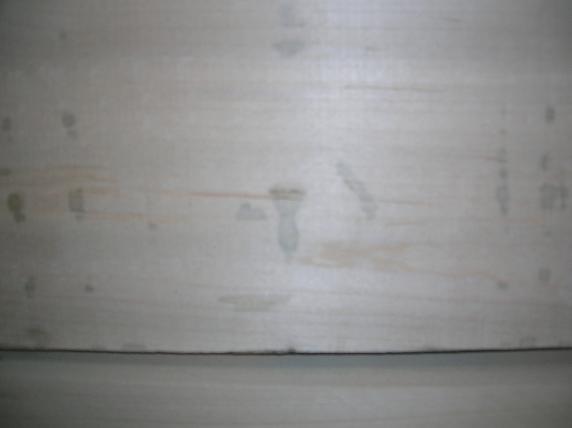Stain Spots on Soft Maple after Kiln Drying
This particular problem was a chemical stain, but the thread also has an interesting discussion of beetle damage. June 13, 2014
Question (WOODWEB Member) :
We're finding grey streaks and spots in some of our soft maple lumber at 13/16". There are some streaks that look like mechanical bruising from a conveyor or dog marks, but the majority of these marks are very random and may only be a spot 1/4" in diameter to 12" streaks. The lumber ranges from fresh cut to gate wood and goes through a fan shed directly after sticking and then into a kiln. The lumber is very bright and white except for these marks. We do get some pressure roll marks showing this same grey color at 15/16, but they usually disappear at 13/16. Does anyone know what causes this and is there a way to prevent them?
Forum Responses
(Commercial Kiln Drying Forum)
From contributor R:
If it looks like the picture below it is caused by the ambrosia beetle and there is no way to get rid of it that I know. If you have some that is intensely marked, you may be able to charge a premium.

Click here for higher quality, full size image
From Gene Wengert, forum technical advisor:
The picture above is the result of the Columbian Timber beetle, which is found in the Southern US. Indeed, pressure marks can go deeper. Some people call this bruising. Sometimes chemical stain goes different depths and so with light planning not all is removed, but there are some small pockets that go deeper. I do believe that this is what you have. Chemical stain is discussed in an article I wrote on stain that is in the archives. Note that sticker stain is a chemical stain also and so what applies to sticker stain applies in your case as well.
Causes and Cures for Stains In Dried Lumber
From the original questioner:
Thanks for your responses. Here's a picture of exactly what we are seeing.

Click here for higher quality, full size image
From Gene Wengert, forum technical advisor:
This is a blotchy stain and is a chemical stain. We see it in hickory and pecan also. It is a result of drying too slowly.
From contributor O:
Gene, how have you arrived at the conclusion that the blotchy chemical stain is triggered by slow drying? If this is the case, why aren't the results more widespread throughout the board and/or charge?
From Gene Wengert, forum technical advisor:
I am not sure if triggered is the correct word. But slow drying does increase the risk and extent of chemical stain. Of course, the depth of the stain is related to many variables and one of them is the permeability of the wood. That is why the stain has various depths of penetration at times.
From contributor K:
Gene, it has been my understanding that the type of discoloration/stain seen in the ambrosia maple above that you credit specifically to the Columbian Timber Beetle, is the result of a non-specific host response. Not just in the ambrosia maple, but also the red stain found in Acer Negundo aka "Boxelder" aka "Flame Boxelder" etc. and many other species as well. I do know for certain in the case of Negundo which I routinely harvest, at least here in north Texas I routinely observe both the Boxelder Bug and the Ambrosia Beetle within the specie. The coloration intensity and hues, and the stain patterns themselves found within the trees are exactly the same regardless of the particular borer.
I am not challenging your statement I am merely taking this opportunity to attempt to learn more about the causation of stain in Acer. Can you give a cite or an explanation about why you state specifically the Columbian Timber Beetle as the cause of the trees response? It seems you are crediting the CTB as the sole possible cause of stain in the photo, but I must be reading more into your statement than you meant? Because the way I have always understood for example is that the Colombian Beetle would be considered a threat to the tree just as the Ambrosia Beetle or Boxelder Bug would be a foreign invader; any such borer would elicit a non-specific (same type of response no matter the foreign invader) response from the tree. My customers receive literature which contains information based on my understanding it this way, so if the conclusions based on my previous research have been incorrect of course I want to know this.
From Gene Wengert, forum technical advisor:
The ambrosia beetle is a beetle that makes very small holes (1/16" dia.) and also has the ambrosia fungus on its feet when laying eggs. This fungus then inoculates the wood and the fungus grows. When the eggs hatch the young eat the fungus as food. I believe this is called a symbiotic relationship. In any case, the holes are often seen with a dark ring around it, the stain being the result of ambrosia fungus. The photo in response two shows the Columbian Timber beetle and not ambrosia beetle. For pictures of the various insects as they affect wood, see "Lumber Defects Caused by Insects, Fungi and Chemical Stains" by H.B. Moore, et al. 1990. Agricultural Extension Service, North Carolina State Univ, Raleigh. Publ AG-425. It is out of print, but most local libraries can get it on interlibrary loan from their state university's library or US Forest Products Lab library or NC State Univ.

